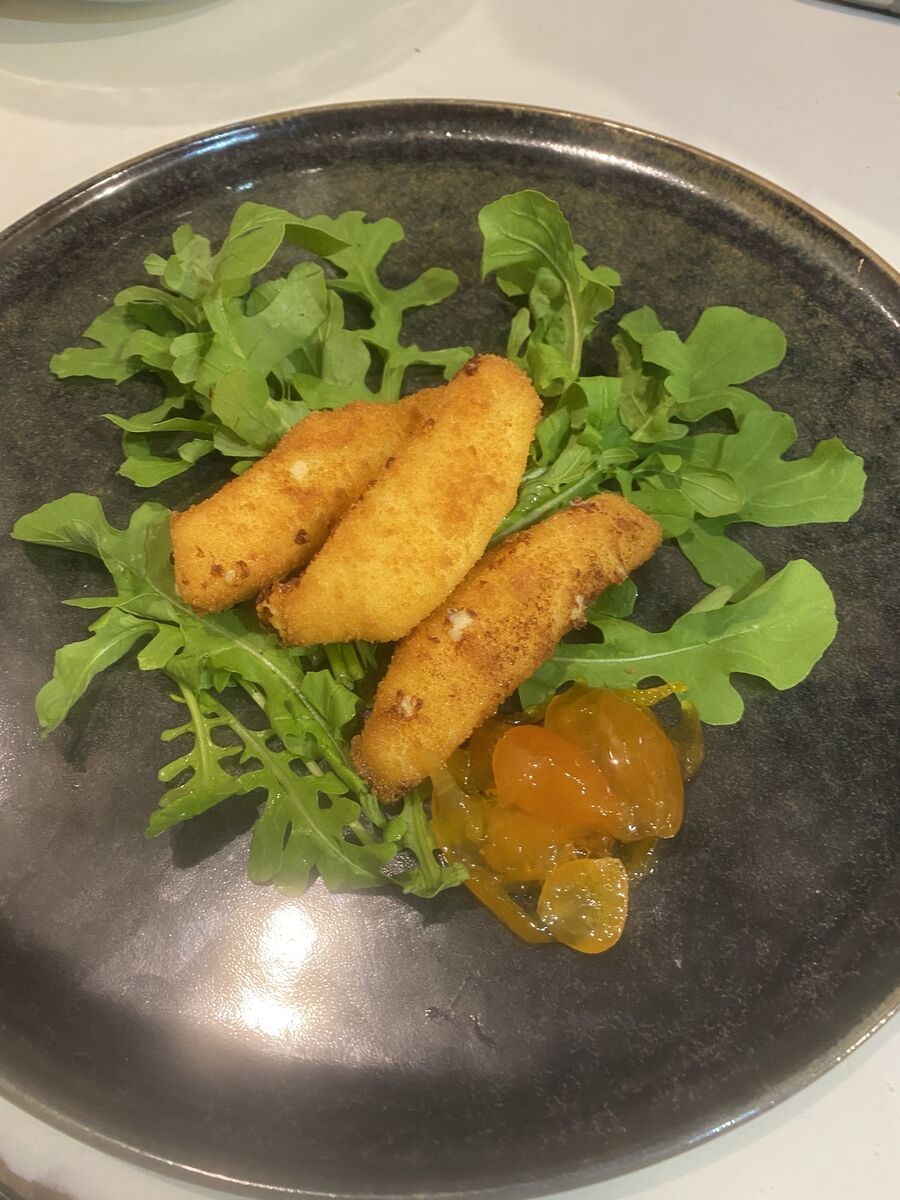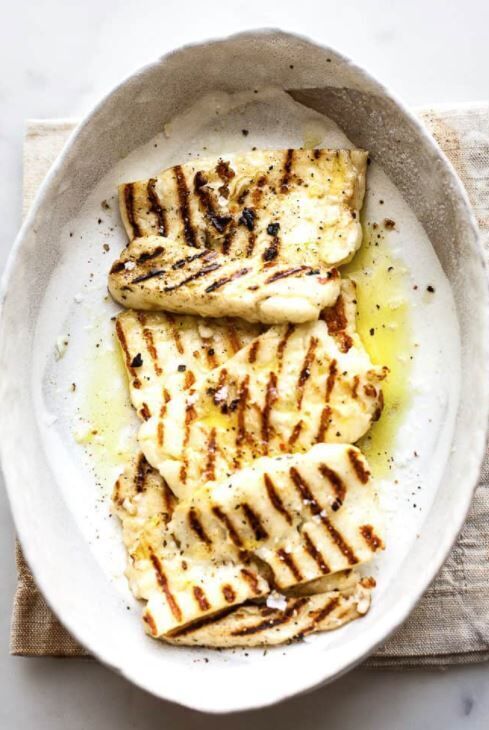Darina Allen: Halloumi fritters with kumquats and rocket leaves

Halloumi and carrot cakes
Many of you already know halloumi, a semi-soft, brined cheese traditionally associated with Cyprus, Turkey and Greece but now there are several delicious versions made here in Ireland. Traditionally it is made all over the island of Cyprus by both the Greek Orthodox and Muslim communities from raw goat or sheep’s milk or a mixture. Halloumi can also be made from cow’s milk. It’s a brilliant, cooking cheese because it has a very high melting point. It holds its shape and is brilliant to add to stews or salads, just fried, grilled or barbequed.
Its super salty, zesty flavour perks up all kinds of dishes that might otherwise be lack lustre. Once you discover halloumi, you’ll probably want to keep a pack permanently in your fridge for a regular halloumi fix. My grandchildren call it ‘squeaky cheese’. Usually, it comes in a block in packages or sliced with a little brine to preserve it — consequently the shelf life can be six months or more.
Sadly the imported halloumi is a long way from the original artisan product made by grandmothers and small farmers on the island of Cyprus. Since global demand has skyrocketed, halloumi is now largely mass produced on an industrial scale so as ever the quality and texture is altogether different.
Halloumi is now widely available in supermarkets, discounters and fast food restaurants which were quick to recognise its appeal and versatility. Think halloumi fritters, burgers, kebabs and fries. So where to find a more artisan product? From February to October on Ballyhubbock Farm in Glen-of-Imaal in the Wicklow mountains, artisan cheesemakers, George Finlay and Hanna Sheerin, make halloumi in the time-honoured way from the milk of their flock of Friesland sheep, ballytubbockfarm@gmail.com, 083 054 1983.
They make the halloumi two to three times a week: it has a shelf life of 8-9 months so during the season they can make enough to supply their devotees throughout the year.
A delicious cow’s milk version comes from Toonsbridge Dairy in West Cork where Toby Simmons and his brilliantly talented innovative team of cheesemakers. But plans are underway to add some buffalo and sheep’s milk before too long. Check out their brilliant new Toonsbridge Food Store and deli on George’s Street in Dublin, it caused quite the stir when it opened in June 2020. They sure deserve our support, as do all the cheesemakers.
Two more hugely skilled cheesemakers, Frank and Gudrun Shinnick of the Fermoy Natural Cheese Company, make a wide range of cheese styles but recently gave me some of their cow’s milk halloumi to taste which I loved and incorporated into many dishes. Once again, made from the beautiful rich milk of their own herd of Friesian cows, pasture-fed on organic feed and tested glyphosate free.
I discovered yet another halloumi at the Ballinrostig Cheese stall at the Midleton Farmer’s Market. This one is made from organic Jersey Cow milk and firmer in texture. They also offer a delicious smoked option
ballinrostighomestead.com
So lots of choice. Here are some of the ways we enjoy halloumi. It’s a rich source of protein, a brilliant meat substitute for vegetarians. Kids and teenagers love it too — encourage them to come up with delicious ways to serve it.
Serves 6
A meal in minutes: fried halloumi cheese cooked in a little round aluminium frying pan called Saganaki, is a Greek speciality.
It must be served piping hot, Greek waiters occasionally run to get it to the customer while it is still bubbling.
- 225g (8ozs) hard cheese, or halloumi
- butter or olive oil
- freshly-squeezed lemon juice
- freshly-ground pepper
Cut the cheese into slices, about 1/2 inch (1cm) thick. Have some white crusty bread ready on the table. Melt a little butter or olive oil in a small frying pan, put in a few slices, reduce the heat and let the cheese cook for 1 or 2 minutes until it begins to bubble. It should not brown, sprinkle with a few drops of lemon juice and some freshly cracked pepper, rush to the table and eat with crusty white bread. Follow with a good green salad.
Serves 4
- 4 pieces of halloumi
- extra virgin olive oil
- zest of 1 organic lemon
- salt and freshly-ground black pepper
- honey — you'll need about 4 teaspoons
- 2-3 teaspoons marjoram or dried oregano
Just before serving, slice the halloumi into 7mm (1/3 inch) thick slices.
Heat a little oil in a pan or pan-grill. Season the cheese with salt and freshly ground black pepper. Arrange the halloumi in a single layer on the pan and allow to sizzle for a couple of minutes on both sides. Sprinkle with coarsely chopped marjoram or dried oregano. Transfer each piece onto a warm plate. Drizzle with a little honey, grate on some lemon zest. Sprinkle with a few fresh marjoram leaves and serve as soon as possible with crusty bread.

Serves 2
- 150g Ballyhubbock Farm artisan halloumi
- Flour seasoned with freshly-ground pepper (no salt)
- 1 beaten egg
- 100grams white bread crumbs
- Extra virgin olive oil
- To Serve
- Kumquat compote (see recipe)
- Rocket leaves
Heat the oil in a deep fryer or 1 inch of oil in a frying pan. Cut the halloumi into 8 fingers and toss in seasoned flour, beaten egg and breadcumbs. Cook for 3 – 4 minutes in the hot oil until crisp and golden.
Toss the rocket leaves in extra virgin olive oil. Divide between 2 plates. Lay 4 fritters on top, drizzle with a little runny honey or serve with kumquat compote.
A gem of a recipe, this compôte can be served as a dessert or as an accompaniment to roast duck, goose or glazed ham. Also delicious with goat’s cheese or yoghurt.
Serves 6-20 depending on how it is served
- 235g (8 1/2 oz) kumquats
- 110g (4oz) sugar
Slice the kumquats thinly into four or five round slices depending on size. Remove the seeds. Put the kumquats into a saucepan with the water and sugar and let them cook very gently, covered, for half an hour or until tender. If they accidently overcook or become too dry, add a little water and bring back to the boil for one minute — they should be crystallised but slightly juicy
Serve warm or cold.
This compote keeps for weeks in the fridge.
These are light and fresh tasting little cakes suitable to serve with a drink, as a starter or indeed would make a lovely accompaniment with their sauces to a platter of grilled lamb chops. The cakes and sauces can be made and kept chilled ahead of time but I do like to serve the cakes as soon after they come off the pan as possible. The different textures here add to the pleasure of eating the dish. The cakes are somewhat firm, that firmness coming mainly from the halloumi. The tahini sauce has the consistency of softly whipped cream and the pomegranate seeds in the minted yoghurt add a little crunch.
- 250g (9oz) carrot, coarsely grated
- 250g (9oz) halloumi, coarsely grated
- 1 beaten egg
- 4 tbsp chopped dill
- 60g (2½oz) plain flour
- 1 heaped tsp cumin seeds, roasted and coarsely ground
- 1 tsp paprika
- Sea salt and freshly-ground pepper
- Extra virgin olive oil for frying
- 125g (4½oz) tahini paste
- 1 clove of garlic, peeled and minced
- A pinch of salt, plus more to taste
- Juice of 1 lemon, plus more to taste
- About 120ml (4½fl oz/) water
Tahini Sauce (see recipe)
Sumac
Place the carrot, halloumi, egg, dill, flour, cumin and paprika in a bowl. Season with salt and pepper and mix well. Taste to ensure the seasoning is correct. Measure out 20g (3/4oz) pieces of the mixture and form into little cakes. Place on a parchment paper-lined tray and chill until ready to cook.
Heat a little oil in a sauté pan and fry the cakes until golden brown on both sides. Keep warm if necessary for a short time in an oven preheated to 100°C/210°F/Gas Mark 1/4.
, place the cakes on a heated flat plate and top each cake with a little dollop of tahini sauce and a light sprinkling of sumac. Serve as soon as possible passing the minted yoghurt separately with a little spoon for guests to serve themselves.
Makes about 240g (8 3/4oz)
- 125g (4 1/2oz) tahini paste
- 1 clove of garlic, peeled and minced
- a pinch of salt, plus more to taste
- juice of 1 lemon, plus more to taste
- about 120ml (4 1/3fl oz/generous 1/2 cup) water
Place the tahini, garlic, salt and lemon juice in a bowl or food processor; add half the water and mix. The mixture will thicken – just continue cautiously adding water while mixing until it loosens up to a creamy texture. You want the sauce to hold its shape on top of the cakes and not to dribble down over the edges. Don’t be tempted to add too much water as the mixture will go runny, but if this happens, you can bring it back to the correct consistency with a little extra tahini paste. Correct seasoning adding more lemon juice.
You can keep tahini in an airtight container in the fridge for 2-3 days, but it will thicken and the flavour may need adjusting with a little more salt and/or lemon. Best made and eaten on same day.
- 250ml natural yoghurt
- 2 tablespoons chopped mint
- 1 tablespoon pomegranate seeds
- ½ teaspoon roasted and ground cumin seed
- Sea salt and freshly-ground black pepper
Mix all of the ingredients together. Taste and correct seasoning.
Serves 10 - 12
- 450g (1lb) curly kale (225g (8oz) when destalked
- lemon, finely-grated zest and juice of one lemon
- 25g (1oz) sugar
- 250ml (9oz) cream
- sea salt — scant teaspoon or to taste
- 150g halloumi, ½ inch dice
Strip the kale off the stalks, chop the leaves fairly finely and massage well to release the juices. Toss in a bowl. Grate the zest of the lemon directly onto the salad. Add the freshly-squeezed juice, a good sprinkling of sugar and some sea salt. Toss, pour the cream over it and toss again.
Heat a little extra virgin olive oil on a pan over a high heat, toss the halloumi cubes until golden on all sides. Scatter over the salad and serve — totally delicious.

Serves 8
- 2 aubergines, cut lengthways into ½-1 cm slices (you’ll need 8 slices in all)
- Extra virgin olive oil
- Sea salt and black pepper
- 500g of halloumi, sliced into 8 lengthways
- Juice of ½ lemon
- 4 teaspoons of annual marjoram
- Pomegranate seeds
- Fresh mint leaves
- Labneh (see recipe)
- Handful of rocket leaves
- 1 garlic clove, crushed
- 5 tablespoons extra virgin olive oil
- 2 tablespoons pomegranate molasses
- Dash of red wine vinegar
- 1 tablespoon honey
- Sea salt and black pepper
Brush each slice of aubergine with the extra virgin olive oil. Season with sea salt and pepper. Preheat a pan over a medium heat, cook slices in batches until golden and tender. Set aside to cool. Place a piece of halloumi at the end of each aubergine slice. A tiny squeeze of lemon juice, sprinkle with chopped marjoram. Roll each aubergine slice up to enclose the halloumi and place on a baking tray. Heat the parcels under a hot grill or in a hot oven until the cheese begins to soften.
Whisk all the ingredients together for the pomegranate dressing with 1 tablespoon water until emulsified.
Serve the parcels on a few rocket leaves, drizzled with the pomegranate dressing. Scatter a few pomegranate seeds and some fresh mint leaves over the top with a blob of labneh on the side.
for the labneh (makes 500g/18oz)
1kg natural yogurt
To make the labneh, line a strainer with a double thickness of sterilised cheesecloth. Place it over a bowl. Pour in the yogurt. Tie the four corners of the cheesecloth to make a loose bundle and suspend the bag of yogurt over a bowl.
Leave it in a cool place to drip into the bowl for 8 hours. Jersey milk yogurt is thicker and needs only 2–3 hours to drip. Then remove the cheesecloth and put the labneh in a bowl. Refrigerate overnight, and store until needed in a covered glass or plastic container. The liquid whey that has drained off can be fed to pigs or hens or used for fermented dishes and in whey lemonade.





